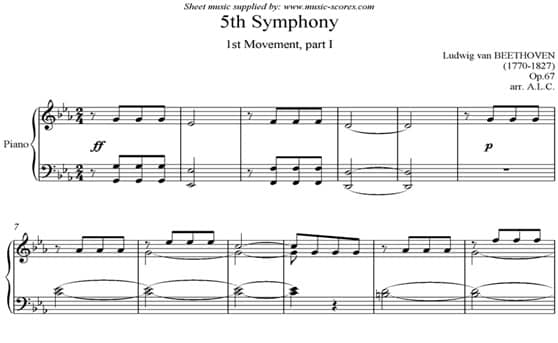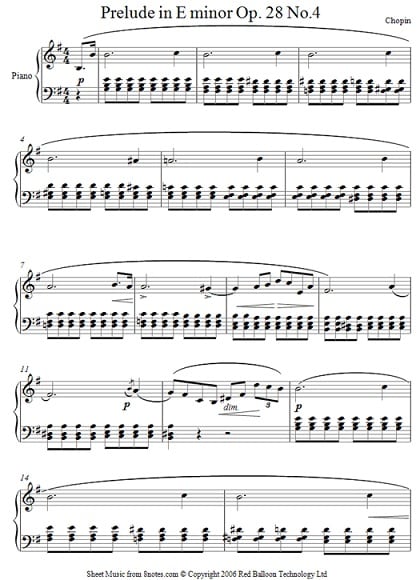
There are countless different types of musical compositions, each with their own focus and form. Their origins have their own stories and purpose, some simply abstract creations built on strict mathematical constructs. Many compositions are brought about through the composer’s desire to express a feeling, portray a place or perhaps capture a moment in real or imagined time. These would include works like the ‘Eroica’ Symphony by Beethoven; ‘La Mer’ by Debussy; or ‘The Rite of Spring’ by Stravinsky. Each of these works was composed for quite specific reasons and in each case with a unique perspective.
Basic Ideas in Musical Composition
If we break down almost any composition, including the three above, we discover that there are common elements that composers employ as the ‘basics’ for their work. It is not that there is a kind of musical template from which anyone could then devise a work of genius, but that there is a commonality that highlights the underlying principles of musical composition. For example, can you imagine a composition without any rhythm? Is it possible to write music that has no structure or dynamic range? I think we can agree that neither of these questions can be answered with a firm ‘yes’ without the next question being ’how?’ What I am trying to illustrate is that from Bruno Mars to Bruckner, there are compositional basics that are a pre-requisite of a composition.
This is an open invitation for you to look more deeply at musical compositions and begin a process of basic analysis. From there it becomes increasingly possible to link a broad variety of works by common threads. Quite often these threads or musical commonalities are considered to be as follows: melody, rhythm and tempo, texture and dynamics, timbre, form and structure. This is not intended to be an exhaustive list but offers a solid starting point from where you can analyse music and understand the basics of musical composition. Under each of these ‘headings’ come sub-categories that in turn assist in the unpacking of any musical composition and likewise inform how to create your work. Modelling your own compositions on the work of others is never a problem, just as long as you are prepared to acknowledge those origins honestly.
One of the most talked-about aspects of musical composition, perhaps because it tends to be the part people remember most, is the melody. Melody can be the easiest way at the start of a new piece of writing, and it can present other possibilities like harmonic shape that then go on to be explored later in the composition. A strong melody can create enough musical material to not only generate a whole composition but to maintain interest and coherence.

Above is an arranged extract from the famous 5th Symphony by Beethoven. You do not need heightened powers of musical analysis to recognise the immediacy and the simplicity of these first few bars, yet Beethoven wove an entire movement from this opening. As melodies go, it is perhaps not the most richly lyrical or expansive, but it is sufficient to snare the listener and provide inspiration for what is to follow. The clever part of this theme is that it starts on a weak beat of the bar (not the first beat of the bar as you might expect), is repetitive and remains harmonically ambiguous. That is to say, Beethoven does not firmly establish the tonality of the piece until later thereby creating a harmonic tension and feeling of unrest that dominates the whole symphony.
By contrast, consider this wonderful miniature by Chopin. This is his Piano Prelude in E minor.

minor
Like the Beethoven theme, Chopin does not embark on a complicated melodic idea of this piece. If you look closely, the rhythmic element of the melody is remarkably straight forward consisting of a dotted minim followed by a crotchet. Where Chopin generates more musical interest is in his use of harmony that essentially is a series of gradually descending inverted chords that give a sense of gentle motion and a certain quiet resignation.
Both pieces present some evidence of the importance of both melody, harmony and rhythm in a composition. If the combination of these basic musical components somehow works then the piece will probably be credible. Add into the mix a clear structure to the music, a framework that holds together all these smaller parts of a piece and there is every possibility it will be successful to listen to and play.
Moving from the details of a piece to the larger aspect, form or structure is a vital part of any composition. You may have written the most compelling melody ever, accompanied by luscious harmonic progressions but without a solid form, it will only be a melody with some pleasant chords. This marks the development from basic ideas towards complete pieces. The formal structures in music have evolved like every other aspect of music. Perhaps in its simplest structure, you could think of a piece of music with a single melody and accompaniment that is stated twice with a modest coda (ending passage), to conclude. This could also include songs that do not have a chorus as such but a verse that has a repeated line at the end, for example, that returns with each new verse.
To extend this simple form you could add a second contrasting idea, often called the ‘B’ section giving you a musical form that would be called ‘binary’ or AB. Many pieces have adopted this structure over centuries and it is a useful starting point for musical composition at basic and far more advanced levels. What distinguishes other more complex musical forms is the development of the melodies or musical material during the piece. Rather than a simple statement of a melody, the composer explores and exploits the material they have composed delving into the very heart of the material they have presented. Beethoven is a remarkable composer in this respect as nothing he writes is wasted, it is self-referential and whole.
There are no hard and fast rules that you have to follow as a composer. Invention, creativity and a willingness to explore outside conventions do offer their own appeal but a secure grasp of the fundamental elements of musical composition is a fruitful and rewarding study to undertake.
